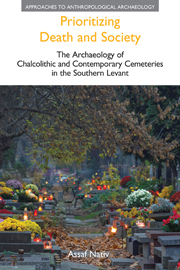 Prioritizing Death and Society
Prioritizing Death and Society Book contents
- Frontmatter
- Dedication
- Contents
- List of figures
- List of tables
- Acknowledgements
- Part I Introduction
- Part II Chalcolithic cemeteries
- Part III Contemporary cemeteries
- 10 An archaeology of us
- 11 The raw materials: from matt to lustre, from grey to colour
- 12 Tombstone morphology: communal trajectories
- 13 Tombstone elaboration: personal expressions
- 14 Spatial patterns: between institutional policy and interpersonal spontaneity
- 15 Intersecting discourses
- Part IV Conclusion
- Appendix: Gazetteers of cemeteries
- Notes
- Bibliography
- Index
13 - Tombstone elaboration: personal expressions
from Part III - Contemporary cemeteries
- Frontmatter
- Dedication
- Contents
- List of figures
- List of tables
- Acknowledgements
- Part I Introduction
- Part II Chalcolithic cemeteries
- Part III Contemporary cemeteries
- 10 An archaeology of us
- 11 The raw materials: from matt to lustre, from grey to colour
- 12 Tombstone morphology: communal trajectories
- 13 Tombstone elaboration: personal expressions
- 14 Spatial patterns: between institutional policy and interpersonal spontaneity
- 15 Intersecting discourses
- Part IV Conclusion
- Appendix: Gazetteers of cemeteries
- Notes
- Bibliography
- Index
Summary
Tombstone elaboration is a fairly common phenomenon, achieved by the application of a variety of figurative and structural additions, serving to enhance, refine or temper the elemental structure to which they are applied. The function of these additions seems to be subsidiary, supporting more specific modes of signalling that operate at a finer level than that of the tombstone itself.
In all, ten elements or motifs tend to recur:
Lantern — a structural element designed to house one or more candles. This feature is often observed in one of two forms: either (a) a relatively small tin or iron vessel with a door in the front and a domed “roof”, capable of containing one and possibly two candles; or (b) a relatively large structure, made of stone or tin and capable of containing a large number of candles at any given moment. Both forms may be found either in the front or the rear of the tombstone; the first variety is sometimes set into a predesigned recess in the tombstone.
Installation — a structure, usually with the upper part open, often encountered as a recess on the tombstone, although observed as an addition as well.
Chalice — a vessel made of plaster, ceramic or glass installed on or near the tombstone. These vessels are narrow and tall and are sometimes found in groups.
Book — an engraved stone addition, shaped like an open book, invariably located on the lower part of the tombstone.
[…]
- Type
- Chapter
- Information
- Prioritizing Death and SocietyThe Archaeology of Chalcolithic and Contemporary Cemeteries in the Southern Levant, pp. 167 - 172Publisher: Acumen PublishingPrint publication year: 2013


